ICT351 Assignment: Ethical Implications of Client Database Management
VerifiedAdded on 2023/06/07
|11
|3540
|397
Report
AI Summary
This report, prepared for an ICT351 assignment, delves into the ethical complexities surrounding client database management within the ICT industry. It begins with an introduction to the ethical challenges faced by ICT professionals, particularly concerning the balance between data privacy and security. The report analyzes a case study involving a client database, applying two key methodologies: the Doing Ethics Technique (DET) and the Australian Computer Society Code of Ethics. The DET is used to identify ethical and non-ethical issues, stakeholders, and potential solutions, focusing on data anonymity, copyright violations, and privacy breaches. The report also applies the Australian Computer Society Code of Ethics, examining issues such as public interest, quality of life, competence, and professionalism. The conclusion emphasizes the importance of ethical decision-making in ICT, advocating for blockchain technology to enhance data anonymity and improve data access control. The report offers recommendations for implementing strict data policies and access controls to mitigate risks and protect client information.
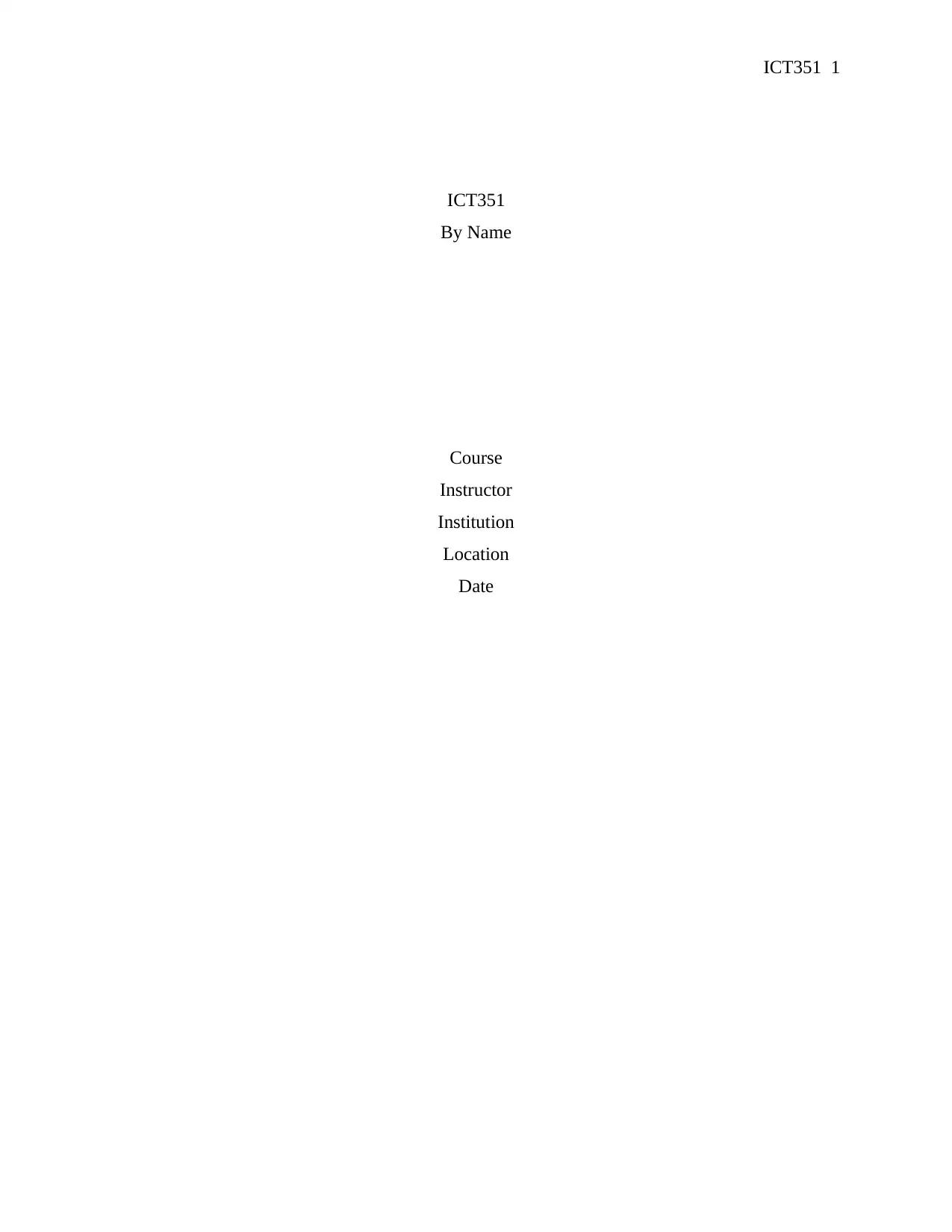
ICT351 1
ICT351
By Name
Course
Instructor
Institution
Location
Date
ICT351
By Name
Course
Instructor
Institution
Location
Date
Paraphrase This Document
Need a fresh take? Get an instant paraphrase of this document with our AI Paraphraser
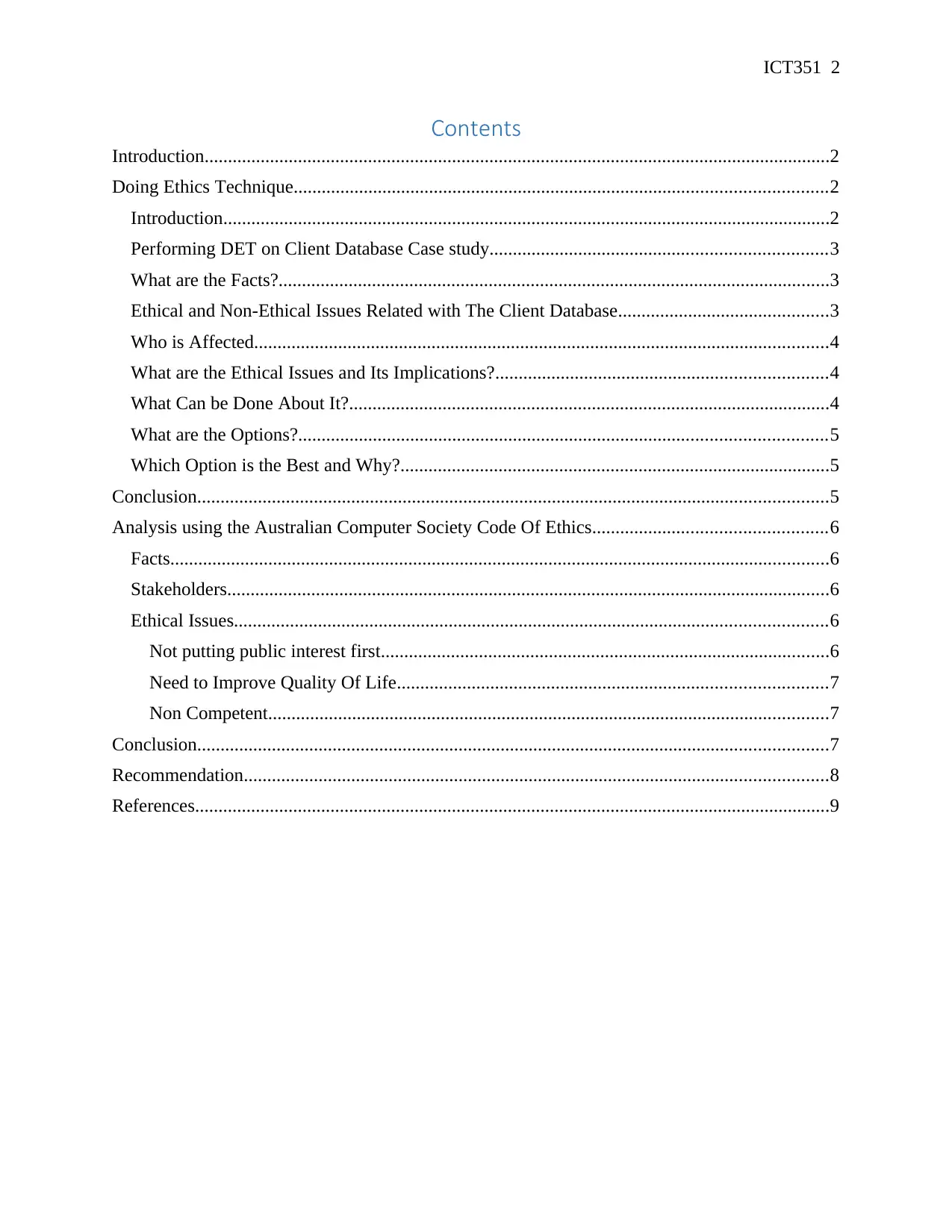
ICT351 2
Contents
Introduction......................................................................................................................................2
Doing Ethics Technique..................................................................................................................2
Introduction..................................................................................................................................2
Performing DET on Client Database Case study........................................................................3
What are the Facts?......................................................................................................................3
Ethical and Non-Ethical Issues Related with The Client Database.............................................3
Who is Affected...........................................................................................................................4
What are the Ethical Issues and Its Implications?.......................................................................4
What Can be Done About It?.......................................................................................................4
What are the Options?.................................................................................................................5
Which Option is the Best and Why?............................................................................................5
Conclusion.......................................................................................................................................5
Analysis using the Australian Computer Society Code Of Ethics..................................................6
Facts.............................................................................................................................................6
Stakeholders.................................................................................................................................6
Ethical Issues...............................................................................................................................6
Not putting public interest first................................................................................................6
Need to Improve Quality Of Life............................................................................................7
Non Competent........................................................................................................................7
Conclusion.......................................................................................................................................7
Recommendation.............................................................................................................................8
References........................................................................................................................................9
Contents
Introduction......................................................................................................................................2
Doing Ethics Technique..................................................................................................................2
Introduction..................................................................................................................................2
Performing DET on Client Database Case study........................................................................3
What are the Facts?......................................................................................................................3
Ethical and Non-Ethical Issues Related with The Client Database.............................................3
Who is Affected...........................................................................................................................4
What are the Ethical Issues and Its Implications?.......................................................................4
What Can be Done About It?.......................................................................................................4
What are the Options?.................................................................................................................5
Which Option is the Best and Why?............................................................................................5
Conclusion.......................................................................................................................................5
Analysis using the Australian Computer Society Code Of Ethics..................................................6
Facts.............................................................................................................................................6
Stakeholders.................................................................................................................................6
Ethical Issues...............................................................................................................................6
Not putting public interest first................................................................................................6
Need to Improve Quality Of Life............................................................................................7
Non Competent........................................................................................................................7
Conclusion.......................................................................................................................................7
Recommendation.............................................................................................................................8
References........................................................................................................................................9
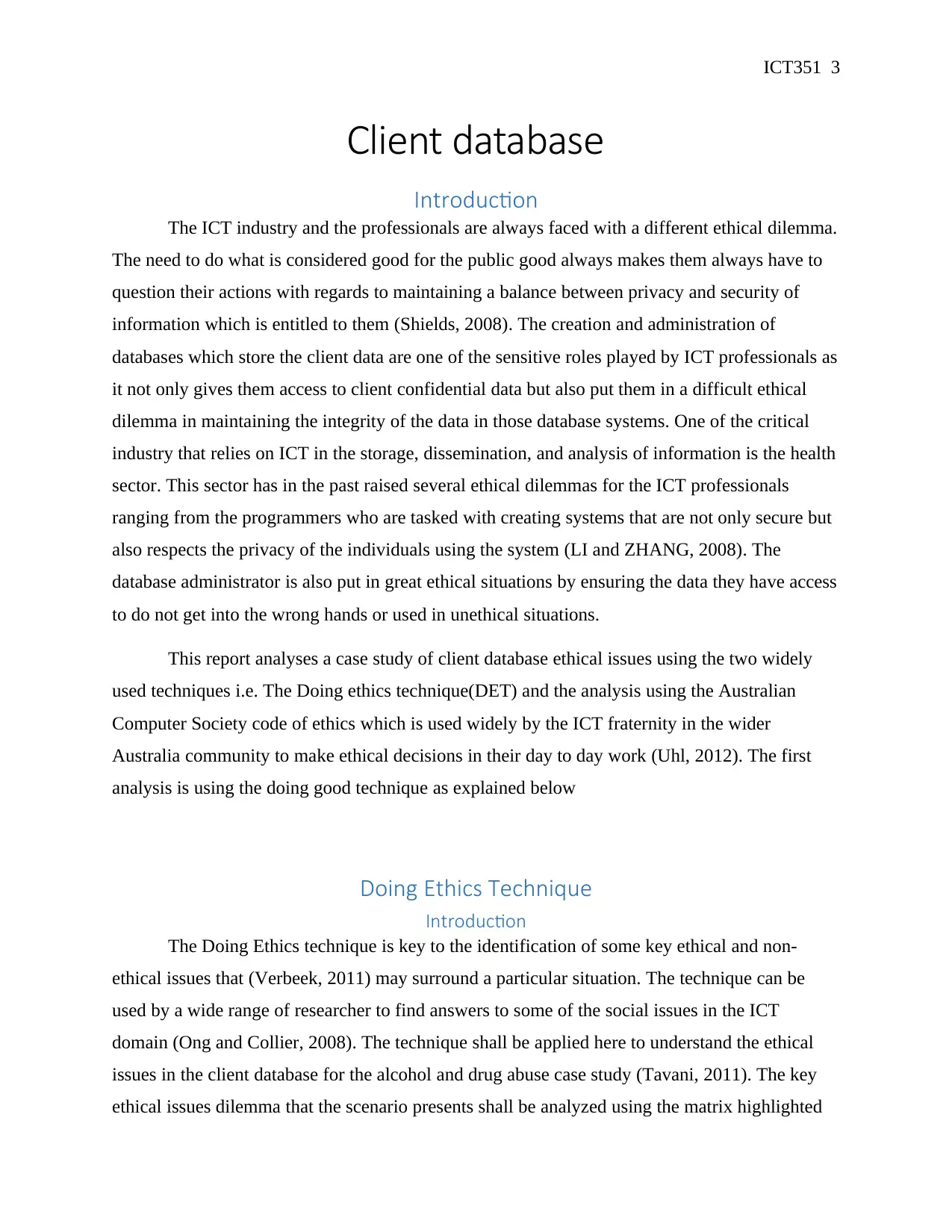
ICT351 3
Client database
Introduction
The ICT industry and the professionals are always faced with a different ethical dilemma.
The need to do what is considered good for the public good always makes them always have to
question their actions with regards to maintaining a balance between privacy and security of
information which is entitled to them (Shields, 2008). The creation and administration of
databases which store the client data are one of the sensitive roles played by ICT professionals as
it not only gives them access to client confidential data but also put them in a difficult ethical
dilemma in maintaining the integrity of the data in those database systems. One of the critical
industry that relies on ICT in the storage, dissemination, and analysis of information is the health
sector. This sector has in the past raised several ethical dilemmas for the ICT professionals
ranging from the programmers who are tasked with creating systems that are not only secure but
also respects the privacy of the individuals using the system (LI and ZHANG, 2008). The
database administrator is also put in great ethical situations by ensuring the data they have access
to do not get into the wrong hands or used in unethical situations.
This report analyses a case study of client database ethical issues using the two widely
used techniques i.e. The Doing ethics technique(DET) and the analysis using the Australian
Computer Society code of ethics which is used widely by the ICT fraternity in the wider
Australia community to make ethical decisions in their day to day work (Uhl, 2012). The first
analysis is using the doing good technique as explained below
Doing Ethics Technique
Introduction
The Doing Ethics technique is key to the identification of some key ethical and non-
ethical issues that (Verbeek, 2011) may surround a particular situation. The technique can be
used by a wide range of researcher to find answers to some of the social issues in the ICT
domain (Ong and Collier, 2008). The technique shall be applied here to understand the ethical
issues in the client database for the alcohol and drug abuse case study (Tavani, 2011). The key
ethical issues dilemma that the scenario presents shall be analyzed using the matrix highlighted
Client database
Introduction
The ICT industry and the professionals are always faced with a different ethical dilemma.
The need to do what is considered good for the public good always makes them always have to
question their actions with regards to maintaining a balance between privacy and security of
information which is entitled to them (Shields, 2008). The creation and administration of
databases which store the client data are one of the sensitive roles played by ICT professionals as
it not only gives them access to client confidential data but also put them in a difficult ethical
dilemma in maintaining the integrity of the data in those database systems. One of the critical
industry that relies on ICT in the storage, dissemination, and analysis of information is the health
sector. This sector has in the past raised several ethical dilemmas for the ICT professionals
ranging from the programmers who are tasked with creating systems that are not only secure but
also respects the privacy of the individuals using the system (LI and ZHANG, 2008). The
database administrator is also put in great ethical situations by ensuring the data they have access
to do not get into the wrong hands or used in unethical situations.
This report analyses a case study of client database ethical issues using the two widely
used techniques i.e. The Doing ethics technique(DET) and the analysis using the Australian
Computer Society code of ethics which is used widely by the ICT fraternity in the wider
Australia community to make ethical decisions in their day to day work (Uhl, 2012). The first
analysis is using the doing good technique as explained below
Doing Ethics Technique
Introduction
The Doing Ethics technique is key to the identification of some key ethical and non-
ethical issues that (Verbeek, 2011) may surround a particular situation. The technique can be
used by a wide range of researcher to find answers to some of the social issues in the ICT
domain (Ong and Collier, 2008). The technique shall be applied here to understand the ethical
issues in the client database for the alcohol and drug abuse case study (Tavani, 2011). The key
ethical issues dilemma that the scenario presents shall be analyzed using the matrix highlighted
⊘ This is a preview!⊘
Do you want full access?
Subscribe today to unlock all pages.

Trusted by 1+ million students worldwide
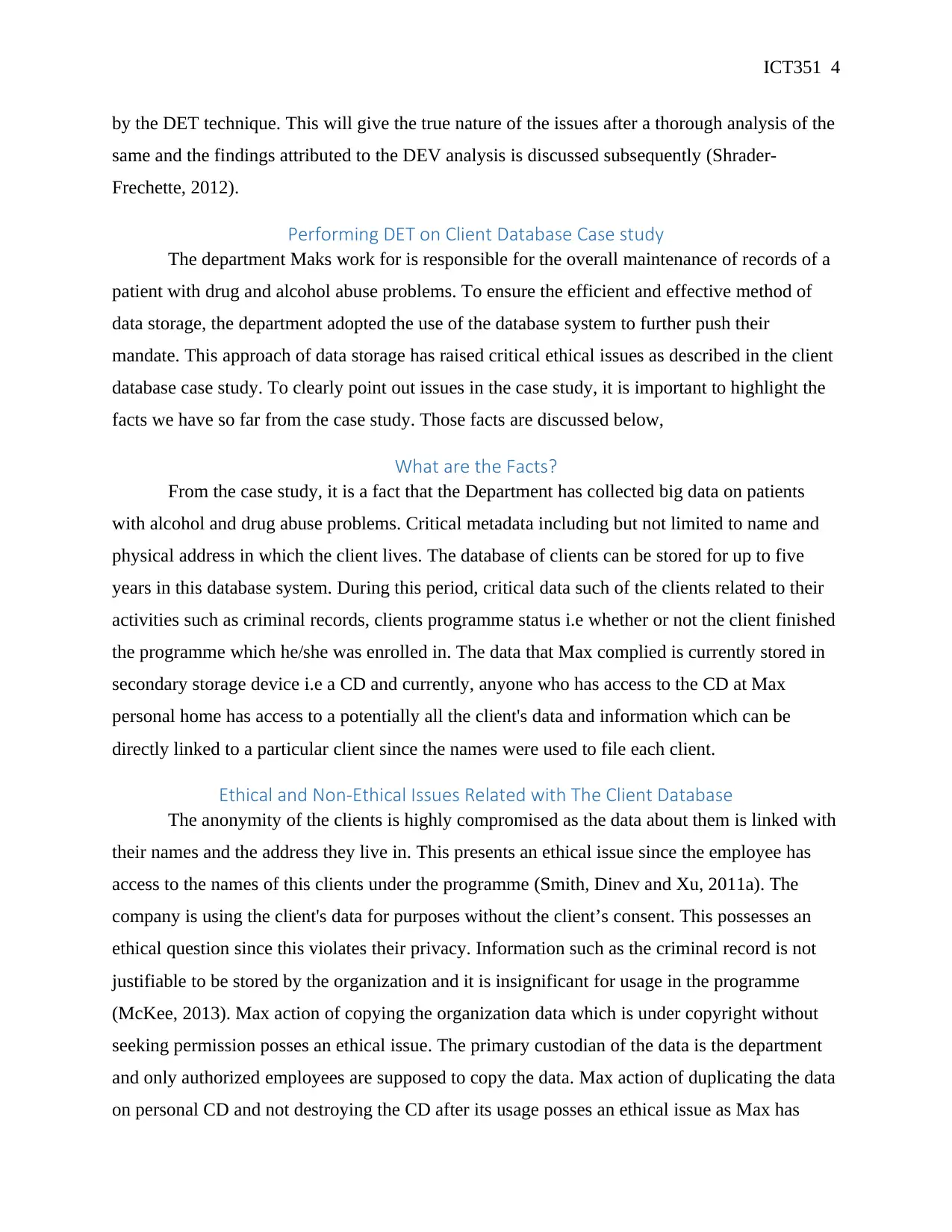
ICT351 4
by the DET technique. This will give the true nature of the issues after a thorough analysis of the
same and the findings attributed to the DEV analysis is discussed subsequently (Shrader-
Frechette, 2012).
Performing DET on Client Database Case study
The department Maks work for is responsible for the overall maintenance of records of a
patient with drug and alcohol abuse problems. To ensure the efficient and effective method of
data storage, the department adopted the use of the database system to further push their
mandate. This approach of data storage has raised critical ethical issues as described in the client
database case study. To clearly point out issues in the case study, it is important to highlight the
facts we have so far from the case study. Those facts are discussed below,
What are the Facts?
From the case study, it is a fact that the Department has collected big data on patients
with alcohol and drug abuse problems. Critical metadata including but not limited to name and
physical address in which the client lives. The database of clients can be stored for up to five
years in this database system. During this period, critical data such of the clients related to their
activities such as criminal records, clients programme status i.e whether or not the client finished
the programme which he/she was enrolled in. The data that Max complied is currently stored in
secondary storage device i.e a CD and currently, anyone who has access to the CD at Max
personal home has access to a potentially all the client's data and information which can be
directly linked to a particular client since the names were used to file each client.
Ethical and Non-Ethical Issues Related with The Client Database
The anonymity of the clients is highly compromised as the data about them is linked with
their names and the address they live in. This presents an ethical issue since the employee has
access to the names of this clients under the programme (Smith, Dinev and Xu, 2011a). The
company is using the client's data for purposes without the client’s consent. This possesses an
ethical question since this violates their privacy. Information such as the criminal record is not
justifiable to be stored by the organization and it is insignificant for usage in the programme
(McKee, 2013). Max action of copying the organization data which is under copyright without
seeking permission posses an ethical issue. The primary custodian of the data is the department
and only authorized employees are supposed to copy the data. Max action of duplicating the data
on personal CD and not destroying the CD after its usage posses an ethical issue as Max has
by the DET technique. This will give the true nature of the issues after a thorough analysis of the
same and the findings attributed to the DEV analysis is discussed subsequently (Shrader-
Frechette, 2012).
Performing DET on Client Database Case study
The department Maks work for is responsible for the overall maintenance of records of a
patient with drug and alcohol abuse problems. To ensure the efficient and effective method of
data storage, the department adopted the use of the database system to further push their
mandate. This approach of data storage has raised critical ethical issues as described in the client
database case study. To clearly point out issues in the case study, it is important to highlight the
facts we have so far from the case study. Those facts are discussed below,
What are the Facts?
From the case study, it is a fact that the Department has collected big data on patients
with alcohol and drug abuse problems. Critical metadata including but not limited to name and
physical address in which the client lives. The database of clients can be stored for up to five
years in this database system. During this period, critical data such of the clients related to their
activities such as criminal records, clients programme status i.e whether or not the client finished
the programme which he/she was enrolled in. The data that Max complied is currently stored in
secondary storage device i.e a CD and currently, anyone who has access to the CD at Max
personal home has access to a potentially all the client's data and information which can be
directly linked to a particular client since the names were used to file each client.
Ethical and Non-Ethical Issues Related with The Client Database
The anonymity of the clients is highly compromised as the data about them is linked with
their names and the address they live in. This presents an ethical issue since the employee has
access to the names of this clients under the programme (Smith, Dinev and Xu, 2011a). The
company is using the client's data for purposes without the client’s consent. This possesses an
ethical question since this violates their privacy. Information such as the criminal record is not
justifiable to be stored by the organization and it is insignificant for usage in the programme
(McKee, 2013). Max action of copying the organization data which is under copyright without
seeking permission posses an ethical issue. The primary custodian of the data is the department
and only authorized employees are supposed to copy the data. Max action of duplicating the data
on personal CD and not destroying the CD after its usage posses an ethical issue as Max has
Paraphrase This Document
Need a fresh take? Get an instant paraphrase of this document with our AI Paraphraser
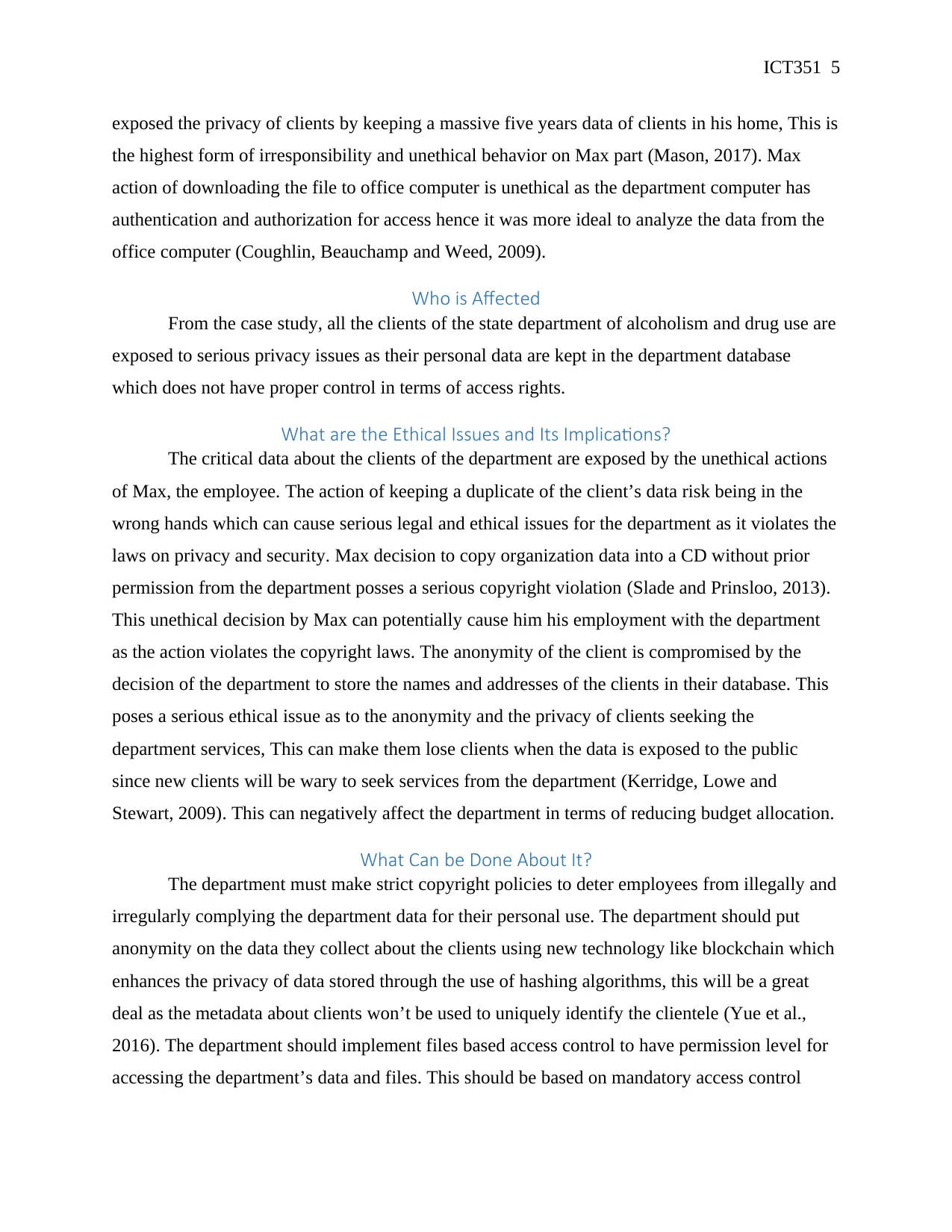
ICT351 5
exposed the privacy of clients by keeping a massive five years data of clients in his home, This is
the highest form of irresponsibility and unethical behavior on Max part (Mason, 2017). Max
action of downloading the file to office computer is unethical as the department computer has
authentication and authorization for access hence it was more ideal to analyze the data from the
office computer (Coughlin, Beauchamp and Weed, 2009).
Who is Affected
From the case study, all the clients of the state department of alcoholism and drug use are
exposed to serious privacy issues as their personal data are kept in the department database
which does not have proper control in terms of access rights.
What are the Ethical Issues and Its Implications?
The critical data about the clients of the department are exposed by the unethical actions
of Max, the employee. The action of keeping a duplicate of the client’s data risk being in the
wrong hands which can cause serious legal and ethical issues for the department as it violates the
laws on privacy and security. Max decision to copy organization data into a CD without prior
permission from the department posses a serious copyright violation (Slade and Prinsloo, 2013).
This unethical decision by Max can potentially cause him his employment with the department
as the action violates the copyright laws. The anonymity of the client is compromised by the
decision of the department to store the names and addresses of the clients in their database. This
poses a serious ethical issue as to the anonymity and the privacy of clients seeking the
department services, This can make them lose clients when the data is exposed to the public
since new clients will be wary to seek services from the department (Kerridge, Lowe and
Stewart, 2009). This can negatively affect the department in terms of reducing budget allocation.
What Can be Done About It?
The department must make strict copyright policies to deter employees from illegally and
irregularly complying the department data for their personal use. The department should put
anonymity on the data they collect about the clients using new technology like blockchain which
enhances the privacy of data stored through the use of hashing algorithms, this will be a great
deal as the metadata about clients won’t be used to uniquely identify the clientele (Yue et al.,
2016). The department should implement files based access control to have permission level for
accessing the department’s data and files. This should be based on mandatory access control
exposed the privacy of clients by keeping a massive five years data of clients in his home, This is
the highest form of irresponsibility and unethical behavior on Max part (Mason, 2017). Max
action of downloading the file to office computer is unethical as the department computer has
authentication and authorization for access hence it was more ideal to analyze the data from the
office computer (Coughlin, Beauchamp and Weed, 2009).
Who is Affected
From the case study, all the clients of the state department of alcoholism and drug use are
exposed to serious privacy issues as their personal data are kept in the department database
which does not have proper control in terms of access rights.
What are the Ethical Issues and Its Implications?
The critical data about the clients of the department are exposed by the unethical actions
of Max, the employee. The action of keeping a duplicate of the client’s data risk being in the
wrong hands which can cause serious legal and ethical issues for the department as it violates the
laws on privacy and security. Max decision to copy organization data into a CD without prior
permission from the department posses a serious copyright violation (Slade and Prinsloo, 2013).
This unethical decision by Max can potentially cause him his employment with the department
as the action violates the copyright laws. The anonymity of the client is compromised by the
decision of the department to store the names and addresses of the clients in their database. This
poses a serious ethical issue as to the anonymity and the privacy of clients seeking the
department services, This can make them lose clients when the data is exposed to the public
since new clients will be wary to seek services from the department (Kerridge, Lowe and
Stewart, 2009). This can negatively affect the department in terms of reducing budget allocation.
What Can be Done About It?
The department must make strict copyright policies to deter employees from illegally and
irregularly complying the department data for their personal use. The department should put
anonymity on the data they collect about the clients using new technology like blockchain which
enhances the privacy of data stored through the use of hashing algorithms, this will be a great
deal as the metadata about clients won’t be used to uniquely identify the clientele (Yue et al.,
2016). The department should implement files based access control to have permission level for
accessing the department’s data and files. This should be based on mandatory access control
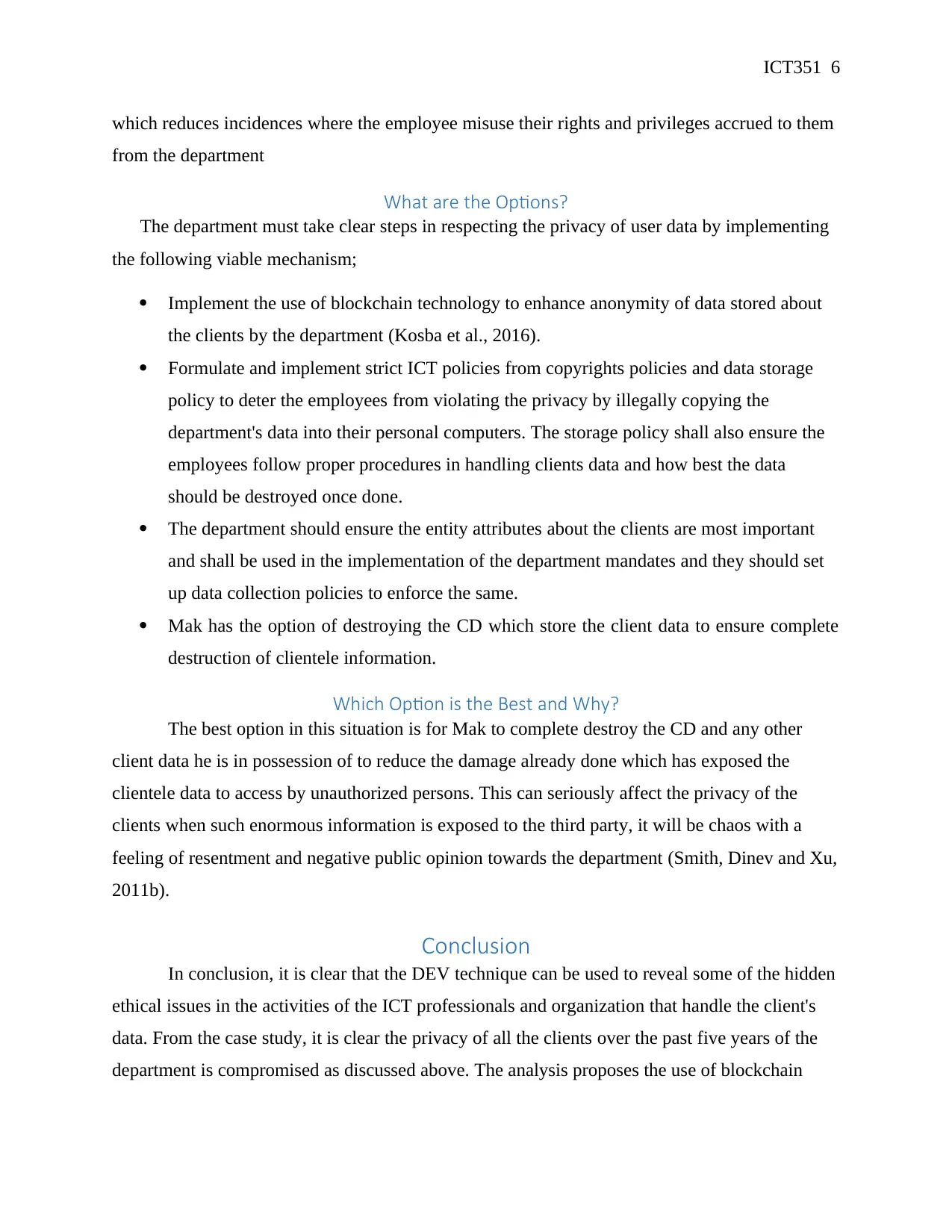
ICT351 6
which reduces incidences where the employee misuse their rights and privileges accrued to them
from the department
What are the Options?
The department must take clear steps in respecting the privacy of user data by implementing
the following viable mechanism;
Implement the use of blockchain technology to enhance anonymity of data stored about
the clients by the department (Kosba et al., 2016).
Formulate and implement strict ICT policies from copyrights policies and data storage
policy to deter the employees from violating the privacy by illegally copying the
department's data into their personal computers. The storage policy shall also ensure the
employees follow proper procedures in handling clients data and how best the data
should be destroyed once done.
The department should ensure the entity attributes about the clients are most important
and shall be used in the implementation of the department mandates and they should set
up data collection policies to enforce the same.
Mak has the option of destroying the CD which store the client data to ensure complete
destruction of clientele information.
Which Option is the Best and Why?
The best option in this situation is for Mak to complete destroy the CD and any other
client data he is in possession of to reduce the damage already done which has exposed the
clientele data to access by unauthorized persons. This can seriously affect the privacy of the
clients when such enormous information is exposed to the third party, it will be chaos with a
feeling of resentment and negative public opinion towards the department (Smith, Dinev and Xu,
2011b).
Conclusion
In conclusion, it is clear that the DEV technique can be used to reveal some of the hidden
ethical issues in the activities of the ICT professionals and organization that handle the client's
data. From the case study, it is clear the privacy of all the clients over the past five years of the
department is compromised as discussed above. The analysis proposes the use of blockchain
which reduces incidences where the employee misuse their rights and privileges accrued to them
from the department
What are the Options?
The department must take clear steps in respecting the privacy of user data by implementing
the following viable mechanism;
Implement the use of blockchain technology to enhance anonymity of data stored about
the clients by the department (Kosba et al., 2016).
Formulate and implement strict ICT policies from copyrights policies and data storage
policy to deter the employees from violating the privacy by illegally copying the
department's data into their personal computers. The storage policy shall also ensure the
employees follow proper procedures in handling clients data and how best the data
should be destroyed once done.
The department should ensure the entity attributes about the clients are most important
and shall be used in the implementation of the department mandates and they should set
up data collection policies to enforce the same.
Mak has the option of destroying the CD which store the client data to ensure complete
destruction of clientele information.
Which Option is the Best and Why?
The best option in this situation is for Mak to complete destroy the CD and any other
client data he is in possession of to reduce the damage already done which has exposed the
clientele data to access by unauthorized persons. This can seriously affect the privacy of the
clients when such enormous information is exposed to the third party, it will be chaos with a
feeling of resentment and negative public opinion towards the department (Smith, Dinev and Xu,
2011b).
Conclusion
In conclusion, it is clear that the DEV technique can be used to reveal some of the hidden
ethical issues in the activities of the ICT professionals and organization that handle the client's
data. From the case study, it is clear the privacy of all the clients over the past five years of the
department is compromised as discussed above. The analysis proposes the use of blockchain
⊘ This is a preview!⊘
Do you want full access?
Subscribe today to unlock all pages.

Trusted by 1+ million students worldwide
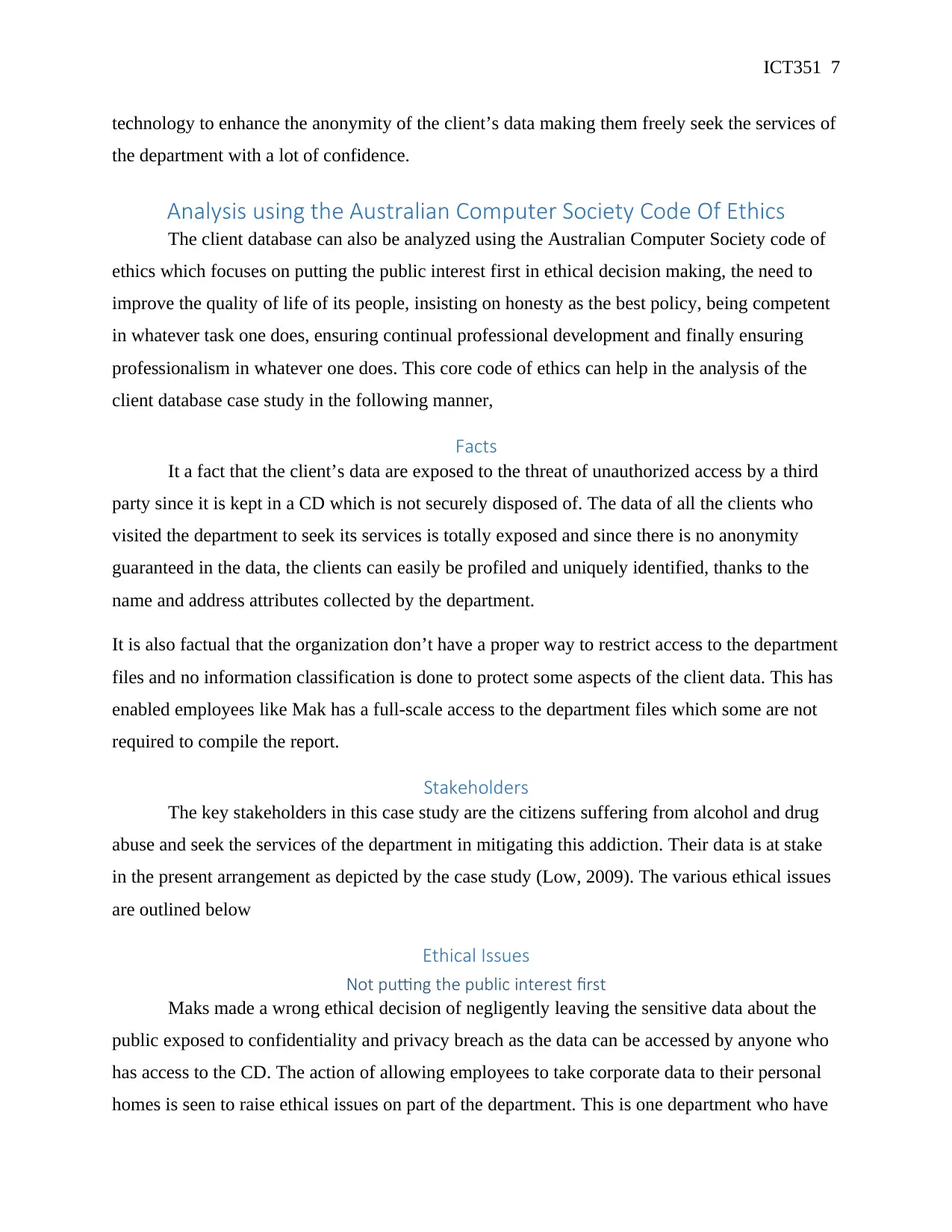
ICT351 7
technology to enhance the anonymity of the client’s data making them freely seek the services of
the department with a lot of confidence.
Analysis using the Australian Computer Society Code Of Ethics
The client database can also be analyzed using the Australian Computer Society code of
ethics which focuses on putting the public interest first in ethical decision making, the need to
improve the quality of life of its people, insisting on honesty as the best policy, being competent
in whatever task one does, ensuring continual professional development and finally ensuring
professionalism in whatever one does. This core code of ethics can help in the analysis of the
client database case study in the following manner,
Facts
It a fact that the client’s data are exposed to the threat of unauthorized access by a third
party since it is kept in a CD which is not securely disposed of. The data of all the clients who
visited the department to seek its services is totally exposed and since there is no anonymity
guaranteed in the data, the clients can easily be profiled and uniquely identified, thanks to the
name and address attributes collected by the department.
It is also factual that the organization don’t have a proper way to restrict access to the department
files and no information classification is done to protect some aspects of the client data. This has
enabled employees like Mak has a full-scale access to the department files which some are not
required to compile the report.
Stakeholders
The key stakeholders in this case study are the citizens suffering from alcohol and drug
abuse and seek the services of the department in mitigating this addiction. Their data is at stake
in the present arrangement as depicted by the case study (Low, 2009). The various ethical issues
are outlined below
Ethical Issues
Not putting the public interest first
Maks made a wrong ethical decision of negligently leaving the sensitive data about the
public exposed to confidentiality and privacy breach as the data can be accessed by anyone who
has access to the CD. The action of allowing employees to take corporate data to their personal
homes is seen to raise ethical issues on part of the department. This is one department who have
technology to enhance the anonymity of the client’s data making them freely seek the services of
the department with a lot of confidence.
Analysis using the Australian Computer Society Code Of Ethics
The client database can also be analyzed using the Australian Computer Society code of
ethics which focuses on putting the public interest first in ethical decision making, the need to
improve the quality of life of its people, insisting on honesty as the best policy, being competent
in whatever task one does, ensuring continual professional development and finally ensuring
professionalism in whatever one does. This core code of ethics can help in the analysis of the
client database case study in the following manner,
Facts
It a fact that the client’s data are exposed to the threat of unauthorized access by a third
party since it is kept in a CD which is not securely disposed of. The data of all the clients who
visited the department to seek its services is totally exposed and since there is no anonymity
guaranteed in the data, the clients can easily be profiled and uniquely identified, thanks to the
name and address attributes collected by the department.
It is also factual that the organization don’t have a proper way to restrict access to the department
files and no information classification is done to protect some aspects of the client data. This has
enabled employees like Mak has a full-scale access to the department files which some are not
required to compile the report.
Stakeholders
The key stakeholders in this case study are the citizens suffering from alcohol and drug
abuse and seek the services of the department in mitigating this addiction. Their data is at stake
in the present arrangement as depicted by the case study (Low, 2009). The various ethical issues
are outlined below
Ethical Issues
Not putting the public interest first
Maks made a wrong ethical decision of negligently leaving the sensitive data about the
public exposed to confidentiality and privacy breach as the data can be accessed by anyone who
has access to the CD. The action of allowing employees to take corporate data to their personal
homes is seen to raise ethical issues on part of the department. This is one department who have
Paraphrase This Document
Need a fresh take? Get an instant paraphrase of this document with our AI Paraphraser
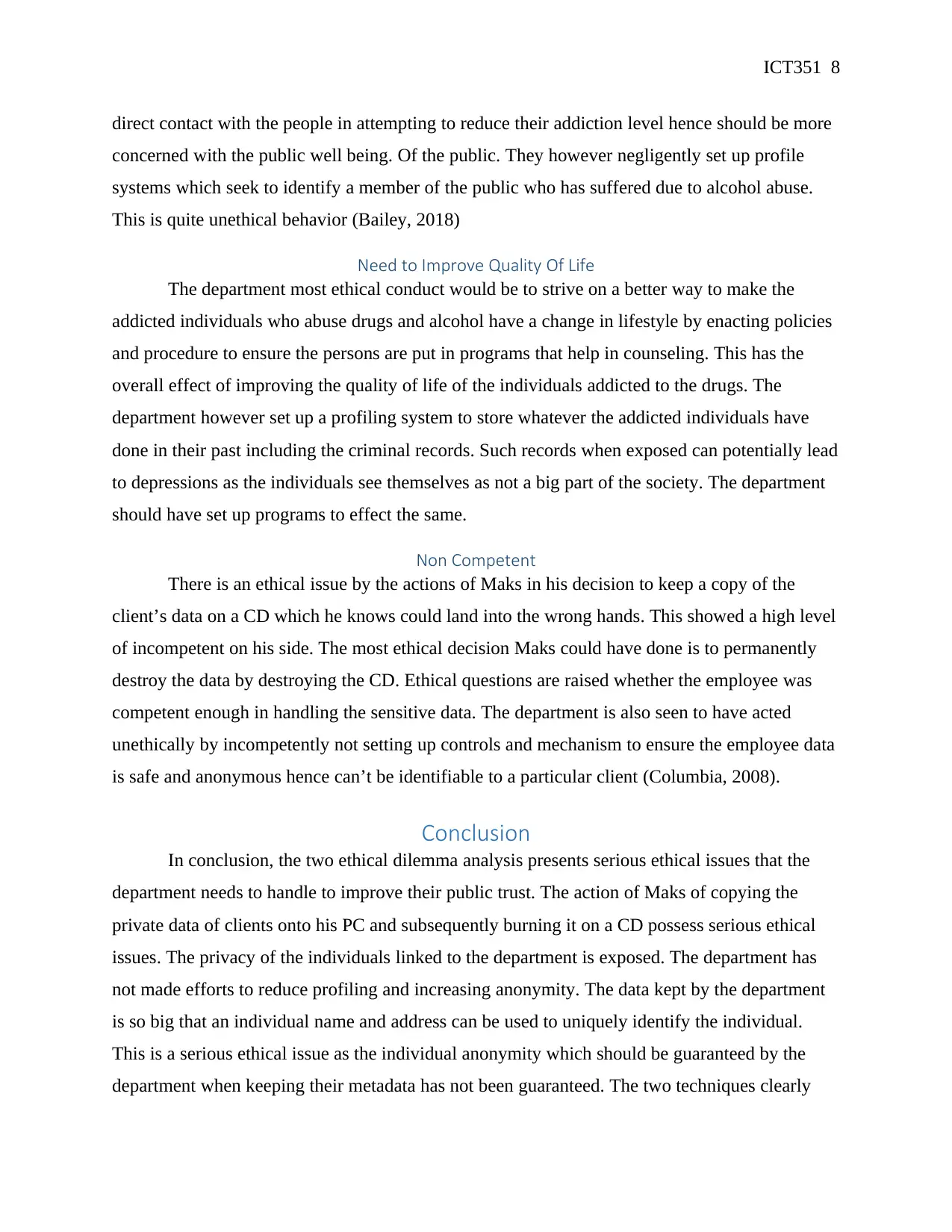
ICT351 8
direct contact with the people in attempting to reduce their addiction level hence should be more
concerned with the public well being. Of the public. They however negligently set up profile
systems which seek to identify a member of the public who has suffered due to alcohol abuse.
This is quite unethical behavior (Bailey, 2018)
Need to Improve Quality Of Life
The department most ethical conduct would be to strive on a better way to make the
addicted individuals who abuse drugs and alcohol have a change in lifestyle by enacting policies
and procedure to ensure the persons are put in programs that help in counseling. This has the
overall effect of improving the quality of life of the individuals addicted to the drugs. The
department however set up a profiling system to store whatever the addicted individuals have
done in their past including the criminal records. Such records when exposed can potentially lead
to depressions as the individuals see themselves as not a big part of the society. The department
should have set up programs to effect the same.
Non Competent
There is an ethical issue by the actions of Maks in his decision to keep a copy of the
client’s data on a CD which he knows could land into the wrong hands. This showed a high level
of incompetent on his side. The most ethical decision Maks could have done is to permanently
destroy the data by destroying the CD. Ethical questions are raised whether the employee was
competent enough in handling the sensitive data. The department is also seen to have acted
unethically by incompetently not setting up controls and mechanism to ensure the employee data
is safe and anonymous hence can’t be identifiable to a particular client (Columbia, 2008).
Conclusion
In conclusion, the two ethical dilemma analysis presents serious ethical issues that the
department needs to handle to improve their public trust. The action of Maks of copying the
private data of clients onto his PC and subsequently burning it on a CD possess serious ethical
issues. The privacy of the individuals linked to the department is exposed. The department has
not made efforts to reduce profiling and increasing anonymity. The data kept by the department
is so big that an individual name and address can be used to uniquely identify the individual.
This is a serious ethical issue as the individual anonymity which should be guaranteed by the
department when keeping their metadata has not been guaranteed. The two techniques clearly
direct contact with the people in attempting to reduce their addiction level hence should be more
concerned with the public well being. Of the public. They however negligently set up profile
systems which seek to identify a member of the public who has suffered due to alcohol abuse.
This is quite unethical behavior (Bailey, 2018)
Need to Improve Quality Of Life
The department most ethical conduct would be to strive on a better way to make the
addicted individuals who abuse drugs and alcohol have a change in lifestyle by enacting policies
and procedure to ensure the persons are put in programs that help in counseling. This has the
overall effect of improving the quality of life of the individuals addicted to the drugs. The
department however set up a profiling system to store whatever the addicted individuals have
done in their past including the criminal records. Such records when exposed can potentially lead
to depressions as the individuals see themselves as not a big part of the society. The department
should have set up programs to effect the same.
Non Competent
There is an ethical issue by the actions of Maks in his decision to keep a copy of the
client’s data on a CD which he knows could land into the wrong hands. This showed a high level
of incompetent on his side. The most ethical decision Maks could have done is to permanently
destroy the data by destroying the CD. Ethical questions are raised whether the employee was
competent enough in handling the sensitive data. The department is also seen to have acted
unethically by incompetently not setting up controls and mechanism to ensure the employee data
is safe and anonymous hence can’t be identifiable to a particular client (Columbia, 2008).
Conclusion
In conclusion, the two ethical dilemma analysis presents serious ethical issues that the
department needs to handle to improve their public trust. The action of Maks of copying the
private data of clients onto his PC and subsequently burning it on a CD possess serious ethical
issues. The privacy of the individuals linked to the department is exposed. The department has
not made efforts to reduce profiling and increasing anonymity. The data kept by the department
is so big that an individual name and address can be used to uniquely identify the individual.
This is a serious ethical issue as the individual anonymity which should be guaranteed by the
department when keeping their metadata has not been guaranteed. The two techniques clearly
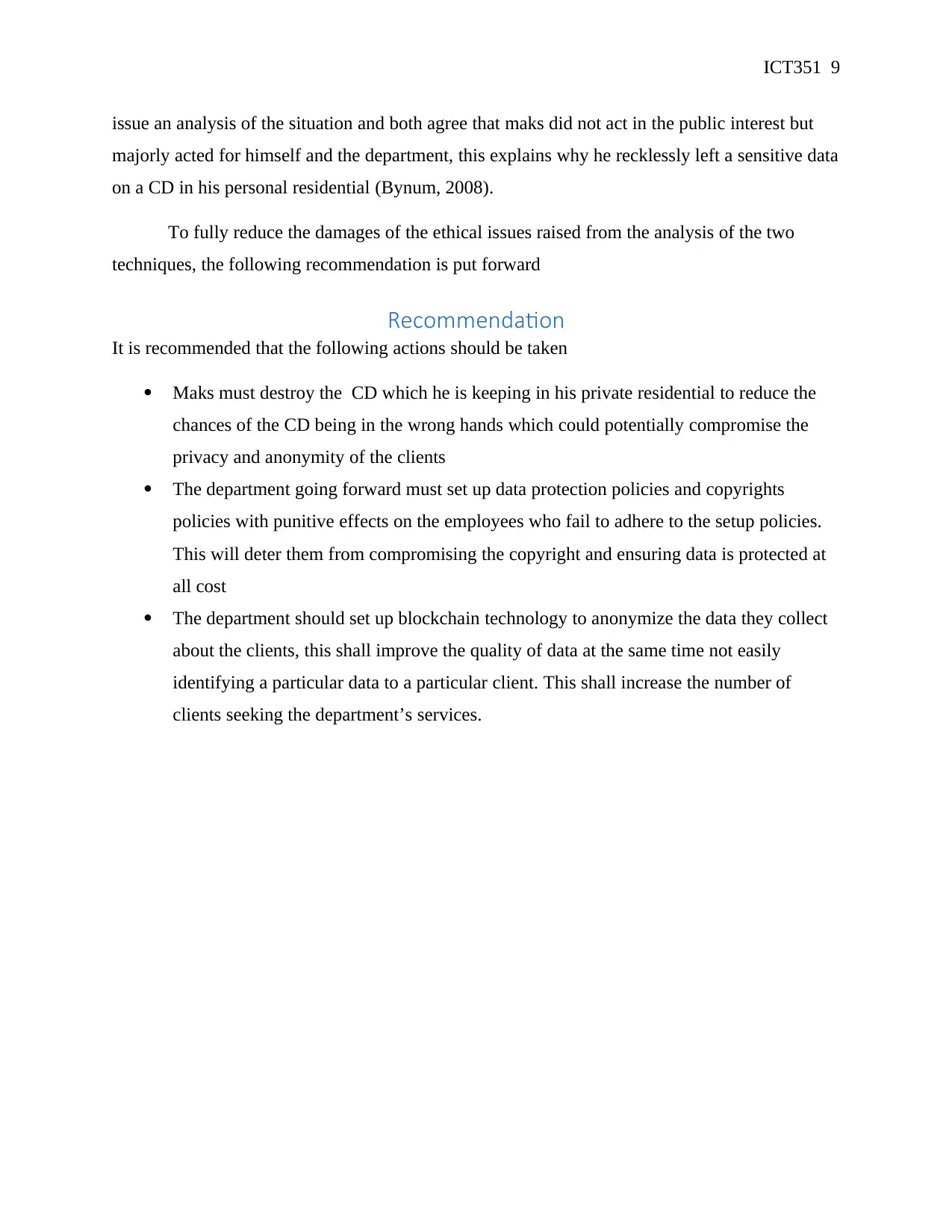
ICT351 9
issue an analysis of the situation and both agree that maks did not act in the public interest but
majorly acted for himself and the department, this explains why he recklessly left a sensitive data
on a CD in his personal residential (Bynum, 2008).
To fully reduce the damages of the ethical issues raised from the analysis of the two
techniques, the following recommendation is put forward
Recommendation
It is recommended that the following actions should be taken
Maks must destroy the CD which he is keeping in his private residential to reduce the
chances of the CD being in the wrong hands which could potentially compromise the
privacy and anonymity of the clients
The department going forward must set up data protection policies and copyrights
policies with punitive effects on the employees who fail to adhere to the setup policies.
This will deter them from compromising the copyright and ensuring data is protected at
all cost
The department should set up blockchain technology to anonymize the data they collect
about the clients, this shall improve the quality of data at the same time not easily
identifying a particular data to a particular client. This shall increase the number of
clients seeking the department’s services.
issue an analysis of the situation and both agree that maks did not act in the public interest but
majorly acted for himself and the department, this explains why he recklessly left a sensitive data
on a CD in his personal residential (Bynum, 2008).
To fully reduce the damages of the ethical issues raised from the analysis of the two
techniques, the following recommendation is put forward
Recommendation
It is recommended that the following actions should be taken
Maks must destroy the CD which he is keeping in his private residential to reduce the
chances of the CD being in the wrong hands which could potentially compromise the
privacy and anonymity of the clients
The department going forward must set up data protection policies and copyrights
policies with punitive effects on the employees who fail to adhere to the setup policies.
This will deter them from compromising the copyright and ensuring data is protected at
all cost
The department should set up blockchain technology to anonymize the data they collect
about the clients, this shall improve the quality of data at the same time not easily
identifying a particular data to a particular client. This shall increase the number of
clients seeking the department’s services.
⊘ This is a preview!⊘
Do you want full access?
Subscribe today to unlock all pages.

Trusted by 1+ million students worldwide
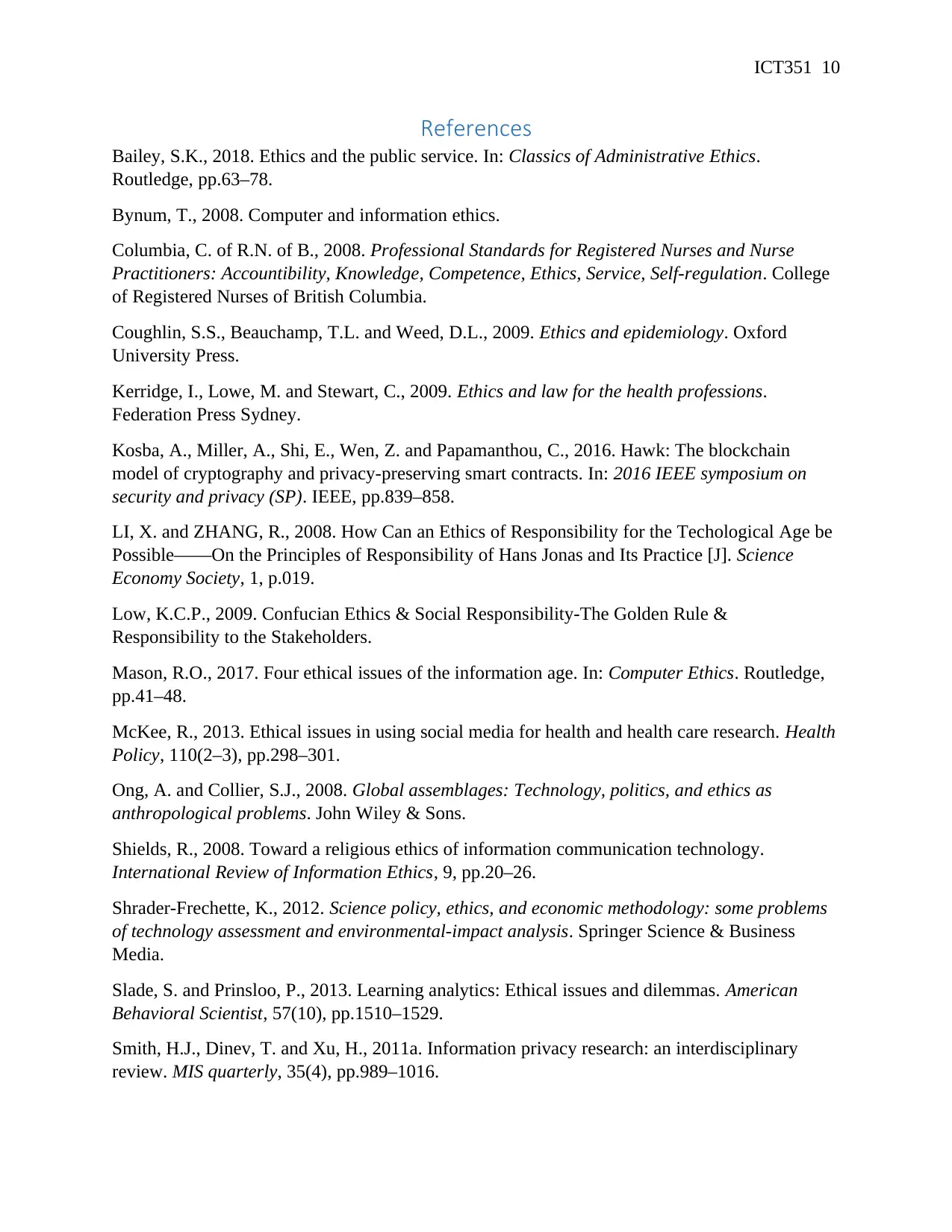
ICT351 10
References
Bailey, S.K., 2018. Ethics and the public service. In: Classics of Administrative Ethics.
Routledge, pp.63–78.
Bynum, T., 2008. Computer and information ethics.
Columbia, C. of R.N. of B., 2008. Professional Standards for Registered Nurses and Nurse
Practitioners: Accountibility, Knowledge, Competence, Ethics, Service, Self-regulation. College
of Registered Nurses of British Columbia.
Coughlin, S.S., Beauchamp, T.L. and Weed, D.L., 2009. Ethics and epidemiology. Oxford
University Press.
Kerridge, I., Lowe, M. and Stewart, C., 2009. Ethics and law for the health professions.
Federation Press Sydney.
Kosba, A., Miller, A., Shi, E., Wen, Z. and Papamanthou, C., 2016. Hawk: The blockchain
model of cryptography and privacy-preserving smart contracts. In: 2016 IEEE symposium on
security and privacy (SP). IEEE, pp.839–858.
LI, X. and ZHANG, R., 2008. How Can an Ethics of Responsibility for the Techological Age be
Possible——On the Principles of Responsibility of Hans Jonas and Its Practice [J]. Science
Economy Society, 1, p.019.
Low, K.C.P., 2009. Confucian Ethics & Social Responsibility-The Golden Rule &
Responsibility to the Stakeholders.
Mason, R.O., 2017. Four ethical issues of the information age. In: Computer Ethics. Routledge,
pp.41–48.
McKee, R., 2013. Ethical issues in using social media for health and health care research. Health
Policy, 110(2–3), pp.298–301.
Ong, A. and Collier, S.J., 2008. Global assemblages: Technology, politics, and ethics as
anthropological problems. John Wiley & Sons.
Shields, R., 2008. Toward a religious ethics of information communication technology.
International Review of Information Ethics, 9, pp.20–26.
Shrader-Frechette, K., 2012. Science policy, ethics, and economic methodology: some problems
of technology assessment and environmental-impact analysis. Springer Science & Business
Media.
Slade, S. and Prinsloo, P., 2013. Learning analytics: Ethical issues and dilemmas. American
Behavioral Scientist, 57(10), pp.1510–1529.
Smith, H.J., Dinev, T. and Xu, H., 2011a. Information privacy research: an interdisciplinary
review. MIS quarterly, 35(4), pp.989–1016.
References
Bailey, S.K., 2018. Ethics and the public service. In: Classics of Administrative Ethics.
Routledge, pp.63–78.
Bynum, T., 2008. Computer and information ethics.
Columbia, C. of R.N. of B., 2008. Professional Standards for Registered Nurses and Nurse
Practitioners: Accountibility, Knowledge, Competence, Ethics, Service, Self-regulation. College
of Registered Nurses of British Columbia.
Coughlin, S.S., Beauchamp, T.L. and Weed, D.L., 2009. Ethics and epidemiology. Oxford
University Press.
Kerridge, I., Lowe, M. and Stewart, C., 2009. Ethics and law for the health professions.
Federation Press Sydney.
Kosba, A., Miller, A., Shi, E., Wen, Z. and Papamanthou, C., 2016. Hawk: The blockchain
model of cryptography and privacy-preserving smart contracts. In: 2016 IEEE symposium on
security and privacy (SP). IEEE, pp.839–858.
LI, X. and ZHANG, R., 2008. How Can an Ethics of Responsibility for the Techological Age be
Possible——On the Principles of Responsibility of Hans Jonas and Its Practice [J]. Science
Economy Society, 1, p.019.
Low, K.C.P., 2009. Confucian Ethics & Social Responsibility-The Golden Rule &
Responsibility to the Stakeholders.
Mason, R.O., 2017. Four ethical issues of the information age. In: Computer Ethics. Routledge,
pp.41–48.
McKee, R., 2013. Ethical issues in using social media for health and health care research. Health
Policy, 110(2–3), pp.298–301.
Ong, A. and Collier, S.J., 2008. Global assemblages: Technology, politics, and ethics as
anthropological problems. John Wiley & Sons.
Shields, R., 2008. Toward a religious ethics of information communication technology.
International Review of Information Ethics, 9, pp.20–26.
Shrader-Frechette, K., 2012. Science policy, ethics, and economic methodology: some problems
of technology assessment and environmental-impact analysis. Springer Science & Business
Media.
Slade, S. and Prinsloo, P., 2013. Learning analytics: Ethical issues and dilemmas. American
Behavioral Scientist, 57(10), pp.1510–1529.
Smith, H.J., Dinev, T. and Xu, H., 2011a. Information privacy research: an interdisciplinary
review. MIS quarterly, 35(4), pp.989–1016.
Paraphrase This Document
Need a fresh take? Get an instant paraphrase of this document with our AI Paraphraser
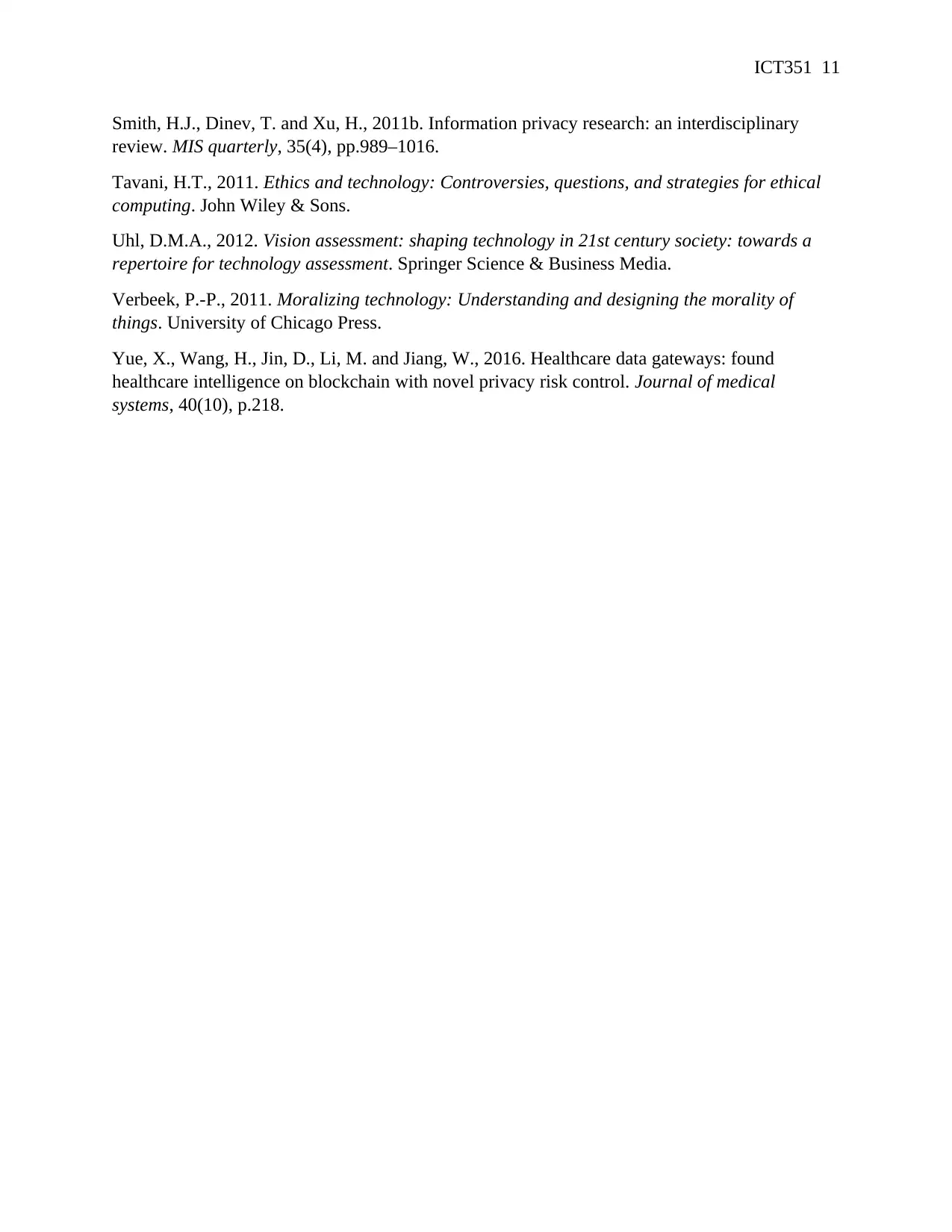
ICT351 11
Smith, H.J., Dinev, T. and Xu, H., 2011b. Information privacy research: an interdisciplinary
review. MIS quarterly, 35(4), pp.989–1016.
Tavani, H.T., 2011. Ethics and technology: Controversies, questions, and strategies for ethical
computing. John Wiley & Sons.
Uhl, D.M.A., 2012. Vision assessment: shaping technology in 21st century society: towards a
repertoire for technology assessment. Springer Science & Business Media.
Verbeek, P.-P., 2011. Moralizing technology: Understanding and designing the morality of
things. University of Chicago Press.
Yue, X., Wang, H., Jin, D., Li, M. and Jiang, W., 2016. Healthcare data gateways: found
healthcare intelligence on blockchain with novel privacy risk control. Journal of medical
systems, 40(10), p.218.
Smith, H.J., Dinev, T. and Xu, H., 2011b. Information privacy research: an interdisciplinary
review. MIS quarterly, 35(4), pp.989–1016.
Tavani, H.T., 2011. Ethics and technology: Controversies, questions, and strategies for ethical
computing. John Wiley & Sons.
Uhl, D.M.A., 2012. Vision assessment: shaping technology in 21st century society: towards a
repertoire for technology assessment. Springer Science & Business Media.
Verbeek, P.-P., 2011. Moralizing technology: Understanding and designing the morality of
things. University of Chicago Press.
Yue, X., Wang, H., Jin, D., Li, M. and Jiang, W., 2016. Healthcare data gateways: found
healthcare intelligence on blockchain with novel privacy risk control. Journal of medical
systems, 40(10), p.218.
1 out of 11
Related Documents
Your All-in-One AI-Powered Toolkit for Academic Success.
+13062052269
info@desklib.com
Available 24*7 on WhatsApp / Email
![[object Object]](/_next/static/media/star-bottom.7253800d.svg)
Unlock your academic potential
Copyright © 2020–2025 A2Z Services. All Rights Reserved. Developed and managed by ZUCOL.




